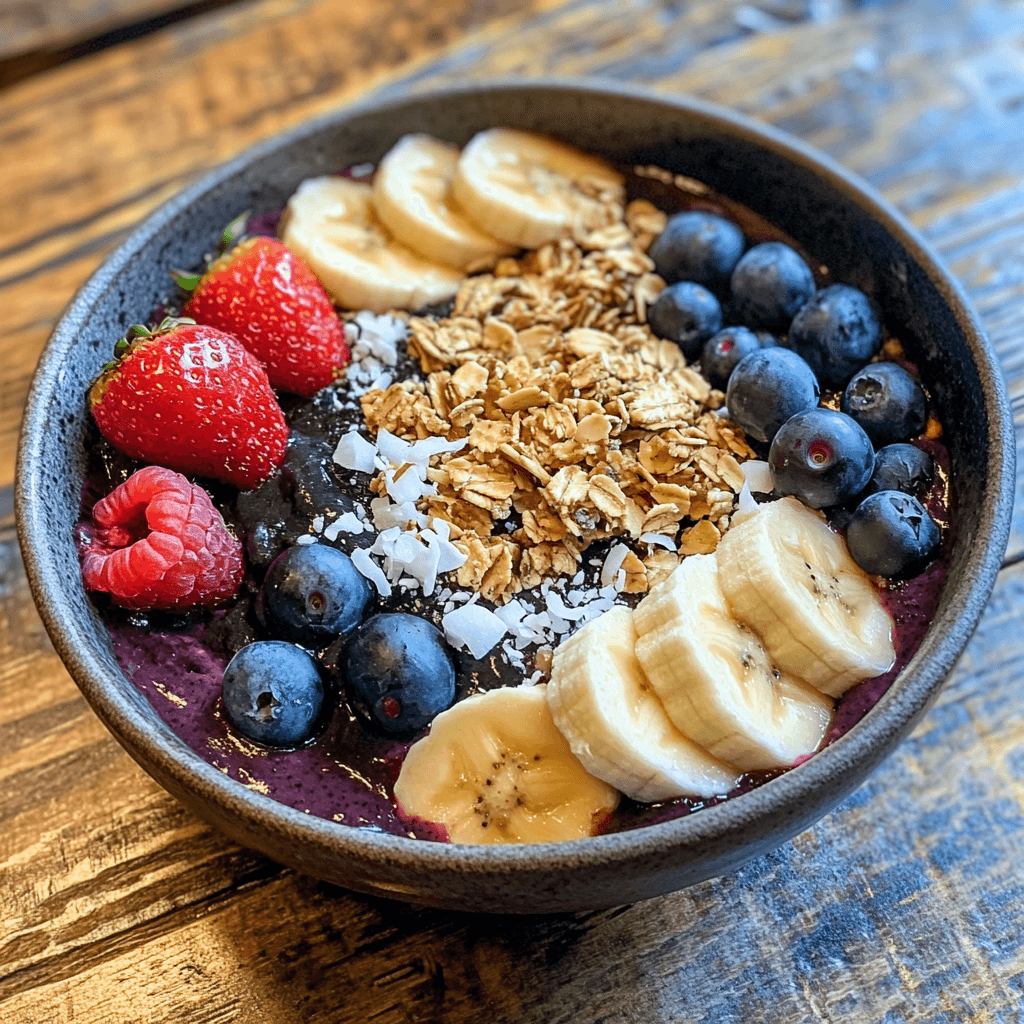Acai bowls have taken the world by storm as a vibrant and Instagram-worthy breakfast or snack option. Packed with fresh fruits, crunchy toppings, and the star ingredient—acai berries—they are often marketed as a superfood powerhouse. But are acai bowls as healthy as they seem? This article breaks down the nutritional benefits, potential downsides, and ways to make them even better for your health. By the end, you’ll know exactly how to enjoy these bowls guilt-free.
What Are Acai Bowls?
Origins of Acai Bowls
Acai bowls originate from Brazil, where locals have long enjoyed acai berries blended into a thick, smoothie-like base. Traditionally, these bowls were simple, topped with bananas or granola, and used as a quick source of energy, especially for surfers. Acai berries themselves come from the acai palm tree, native to the Amazon rainforest.
In the late 1990s, acai made its way to Western diets, quickly becoming a health food sensation. Today, acai bowls have evolved, featuring elaborate toppings and creative add-ins, making them both delicious and highly customizable.
Main Ingredients in Acai Bowls
The foundation of an acai bowl is the acai berry, which is blended with other fruits, juices, or non-dairy milk to create a creamy texture. Acai is rich in antioxidants, particularly anthocyanins, which give the berries their deep purple hue.
Popular toppings include:
- Fresh Fruits: Berries, bananas, and kiwi slices.
- Crunchy Add-Ins: Granola, seeds, or nuts.
- Sweet Enhancers: Honey, coconut flakes, or chocolate chips.
The versatility of acai bowls makes them a favorite for health enthusiasts, though the ingredients you choose can significantly impact how healthy your bowl truly is.
Nutritional Overview of Acai Bowls
Macronutrients and Micronutrients
Acai bowls pack a nutritional punch, offering a mix of macronutrients and micronutrients that can fuel your body. The acai berry, the star ingredient, is naturally low in sugar and high in fiber. It also contains healthy fats like omega-3s, omega-6s, and omega-9s, making it unique among fruits.
These bowls are also rich in micronutrients, such as:
- Vitamin A: For eye health and immune support.
- Calcium: Important for strong bones and teeth.
- Potassium: Helps regulate blood pressure and muscle function.
Additionally, acai berries are loaded with antioxidants, particularly anthocyanins, which help combat free radicals and reduce inflammation. While the base is nutrient-dense, toppings like fresh fruits and nuts can further boost the fiber, vitamins, and minerals in the bowl.
Added Sugars and Caloric Considerations
However, not all acai bowls are created equal. Many store-bought or café versions can sneak in added sugars through sweetened acai purees, syrups, or high-sugar toppings like granola and honey. These extras can turn a healthy snack into a calorie-laden treat.
A standard acai bowl ranges from 200 to 600 calories, depending on portion size and toppings. For a healthier option, opt for unsweetened acai puree and limit sugary add-ons. Balancing the bowl with protein (like Greek yogurt) and healthy fats (like almond butter) can help keep you full longer.
Health Benefits of Acai Bowls
Rich in Antioxidants
One of the biggest draws of acai bowls is their antioxidant power. Acai berries contain higher levels of antioxidants than blueberries, cranberries, or strawberries. These antioxidants neutralize free radicals, reducing oxidative stress in your body. Over time, this can help protect against chronic illnesses like heart disease and certain cancers.
Heart Health and Cholesterol
Acai berries are also celebrated for their heart-healthy benefits. They may help reduce bad cholesterol (LDL) levels and increase good cholesterol (HDL), thanks to their high fiber and healthy fat content. Adding toppings like chia seeds or walnuts further enhances these heart-boosting properties.
Support for Digestion and Immunity
Fiber plays a starring role in acai bowls, promoting better digestion and gut health. A single bowl can provide a significant portion of your daily fiber needs, keeping your digestive system running smoothly.
Moreover, acai berries are believed to strengthen the immune system due to their antioxidant and anti-inflammatory properties. When paired with nutrient-rich toppings like fresh fruit and seeds, acai bowls become a delicious way to support overall wellness.
Potential Downsides of Acai Bowls
High Calorie and Sugar Content
While acai bowls are often celebrated as a healthy choice, they can quickly become calorie-heavy and sugar-laden depending on how they’re made. Many commercial acai bowls, though visually appealing, use sweetened acai purees or fruit juices as a base. Combine this with toppings like granola, honey, or chocolate chips, and a single bowl can easily exceed 600 calories and contain over 40 grams of sugar.
For those questioning, are acai bowls healthy, it’s important to evaluate these hidden extras. Excessive sugar intake can lead to energy crashes, weight gain, and long-term health risks like type 2 diabetes. To keep your acai bowl balanced, opt for unsweetened acai puree and naturally sweet fruits like berries or bananas. Small changes like these can make a big difference in the overall healthfulness of your bowl.
Over-Reliance on Acai Bowls
Another potential downside is the overuse of acai bowls as a meal replacement. While they are nutrient-rich, they often lack the necessary protein and fats to serve as a balanced meal. This can leave you feeling hungry shortly after eating, especially if your bowl is primarily carbs and sugars.
To make acai bowls more filling, consider adding ingredients like Greek yogurt, nut butter, or protein powder. These additions improve satiety and ensure you’re getting a well-rounded nutrient profile.
Allergies and Digestive Issues
Although rare, some individuals may experience allergies to acai berries or certain toppings commonly used in bowls. Symptoms can range from mild itching to more severe reactions. Additionally, the high fiber content in acai and its toppings might cause digestive discomfort for those with sensitive stomachs.
To minimize these risks, start with smaller portions if you’re new to acai bowls and avoid high-fiber toppings like flaxseeds or chia seeds until your body adjusts.
Environmental and Economic Considerations
There’s also a less-discussed downside to acai bowls: their environmental impact. Acai berries are primarily harvested from the Amazon rainforest, raising concerns about sustainability and deforestation. Choosing brands that prioritize ethical and sustainable sourcing can help mitigate this impact.
Economically, acai bowls can be pricey, especially when purchased at cafes or specialty stores. Homemade versions not only cost less but also allow you to control the ingredients for a healthier and more sustainable option.
For more creative and cost-effective recipe ideas, explore Yearly Recipes’ Tropical Smoothie Bowls, which offer similar health benefits with a budget-friendly twist.
Tips for Making Healthier Acai Bowls
Choosing Low-Sugar Bases and Toppings
One of the simplest ways to answer are acai bowls healthy is by focusing on their preparation. Start with an unsweetened acai puree, avoiding blends that include added sugars or artificial sweeteners. These options not only taste better but also allow the natural flavors of the berries to shine through.
For toppings, prioritize nutrient-dense choices. Fresh fruits like blueberries, strawberries, or kiwi add natural sweetness and antioxidants. Sprinkle on seeds like chia or flax for a boost of fiber and omega-3s. For added crunch, try unsweetened granola or a handful of crushed nuts.
Avoid calorie-heavy toppings like whipped cream or chocolate syrup, which can overshadow the bowl’s health benefits. Instead, opt for a drizzle of honey or a sprinkle of coconut flakes for a hint of indulgence without going overboard.
Balancing Macronutrients
To ensure your acai bowl is more than just a sugar rush, focus on balancing its macronutrients. Acai itself is high in healthy fats, but adding protein and additional fats can transform it into a complete meal.
Here are some ways to enhance your bowl’s nutritional profile:
- Protein: Add a scoop of protein powder, a dollop of Greek yogurt, or a spoonful of peanut butter.
- Healthy Fats: Incorporate avocado slices, unsweetened coconut milk, or almond butter for a creamy texture.
- Complex Carbs: Use oats or quinoa as a base layer for a hearty twist.
These adjustments ensure that your acai bowl keeps you full and energized for hours.
Experimenting with Flavors
Another advantage of making acai bowls at home is the opportunity to experiment with flavors. Try blending the acai puree with greens like spinach or kale for added nutrients without altering the taste. You can also mix in spices like cinnamon or ginger for a unique flavor profile.
If you’re feeling adventurous, swap traditional bases for alternatives like coconut water or almond milk. These substitutions not only add variety but also enhance the bowl’s hydration and nutrient content.
Making Acai Bowls Budget-Friendly
Acai bowls can be expensive, especially if you buy them regularly from cafes. Preparing them at home is not only healthier but also much more cost-effective. Purchase acai puree in bulk, freeze fresh fruits, and stock up on versatile toppings that you can use across multiple meals.
By adopting these tips, you can enjoy acai bowls as a guilt-free treat that fits your health goals and budget. This approach ensures that the answer to are acai bowls healthy is a confident yes, provided they’re made mindfully.
Frequently Asked Questions (FAQs)
Are Acai Bowls Good for Weight Loss?
The answer depends on how the bowl is prepared. If you’re wondering, are acai bowls healthy for weight loss, the key lies in portion control and ingredient selection. Acai itself is low in calories and sugar, making it a great base. However, many acai bowls are loaded with calorie-dense toppings like granola, nut butter, and sweetened fruit purees.
To make your acai bowl weight-loss-friendly, use unsweetened acai puree and limit high-calorie toppings. Add protein-rich ingredients like Greek yogurt or a sprinkle of seeds to keep you fuller for longer. This balance ensures you enjoy the benefits of acai while staying on track with your weight goals.
Can Diabetics Eat Acai Bowls?
Yes, but with some adjustments. Many diabetics ask, are acai bowls healthy for them, given the potential for high sugar content. The good news is that acai berries have a low glycemic index, meaning they don’t spike blood sugar levels significantly. The challenge lies in the added sugars often found in commercial acai bowls.
Diabetics can enjoy acai bowls by skipping sweetened purees and sugary toppings. Instead, focus on fresh berries, unsweetened almond milk, and a handful of nuts for added texture and flavor. These swaps make the bowl delicious and diabetic-friendly.

